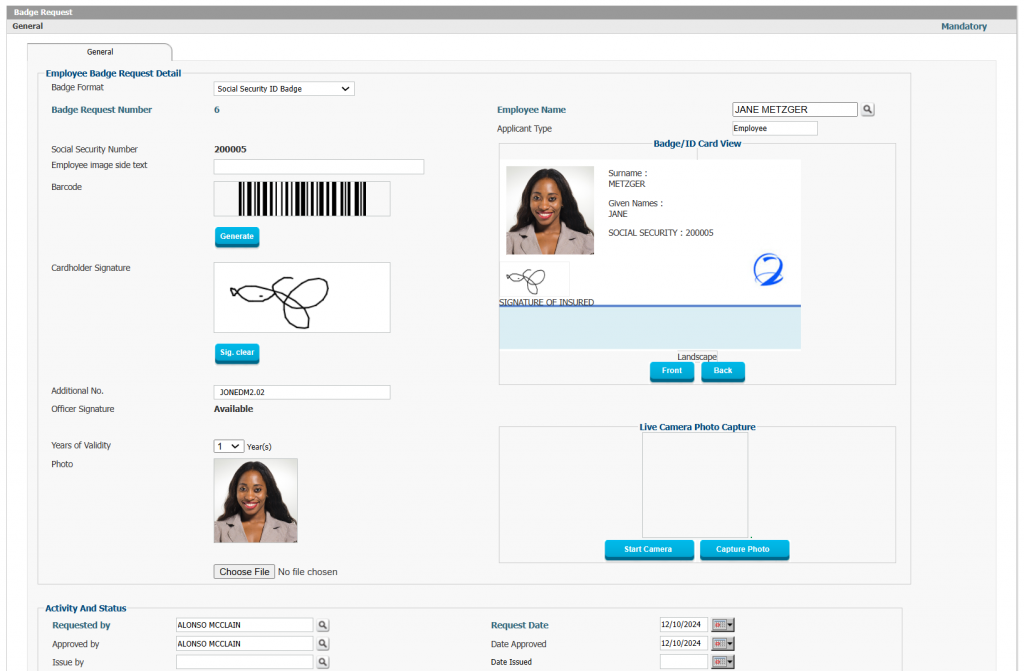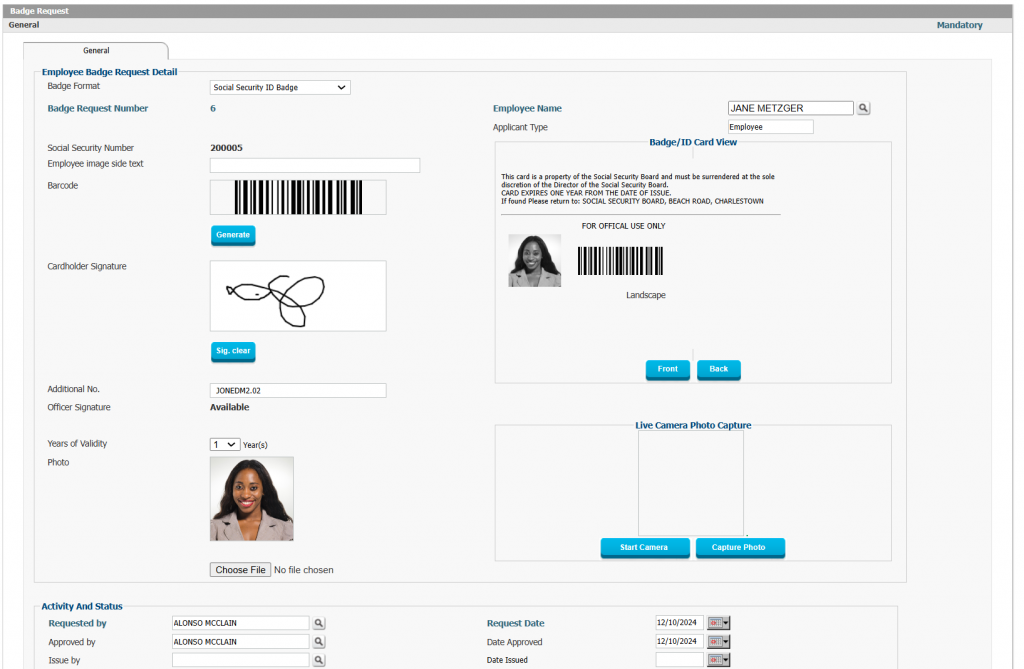Social Security ID cards play a vital role in establishing identity and accessing social welfare programs across different countries. While their design, purpose, and usage vary significantly, their evolution reflects the changing dynamics of identity verification, technology, and the need for privacy and fraud prevention. This blog explores the history, evolution, and current usage of social security ID cards in the United States, Canada, the United Kingdom, and the Caribbean, along with their broader implications.
The History and Evolution of Social Security ID Cards
United States
Social Security cards in the United States were introduced in 1936 as part of the implementation of the Social Security Act of 1935. Originally, the cards were simple paper-based identifiers issued to track workers’ contributions to the Social Security system. Over time, they became a de facto identity document, despite carrying a disclaimer that they were not to be used as identification.
Modern versions of the card have minimal security features, such as anti-counterfeiting elements, but they remain primarily a physical record of the Social Security Number (SSN), with no photograph or biometric data.
Canada
Canada’s approach has been more limited. The Social Insurance Number (SIN) was introduced in 1964, accompanied by simple paper cards that served as a proof of SIN issuance. Unlike the U.S., these cards are rarely used for identification purposes, and their issuance was discontinued in 2014. Canadians now rely on SIN documentation in digital or physical forms, but the card itself is no longer in circulation.
United Kingdom
The UK never issued a dedicated social security card akin to those in the U.S. or Canada. Instead, the National Insurance Number (NINo), introduced in 1948, was recorded in a “National Insurance card,” which was eventually phased out. Today, the NINo is provided on paper notifications, with no specific card issued for social security purposes.
Caribbean
Many Caribbean nations issue social security ID cards, often as part of broader national identification systems. These cards usually include details such as the holder’s name, photograph, and social security number, and they sometimes double as national ID cards. For example, in Barbados and Jamaica, the cards are integral to accessing benefits and are widely accepted as a form of official identification.
Purpose and Primary Use of Social Security ID Cards
The primary purpose of social security ID cards is to authenticate an individual’s identity within the social welfare system. Across regions, they are used to:
- Verify eligibility for benefits such as pensions, unemployment assistance, or healthcare.
- Track contributions to national insurance or pension systems.
- Facilitate access to services provided by the government.
However, their broader use varies:
- In the U.S., the card is often requested by employers for payroll purposes, but it is not used routinely as a general ID.
- In Canada, the SIN documentation is restricted to specific uses, such as tax reporting and employment, and citizens are discouraged from using it for non-official purposes.
- In the UK, the lack of a card prevents misuse, but the NINo is necessary for employment and benefit claims.
- In the Caribbean, the cards are often used for banking, healthcare access, and other daily transactions, reflecting their utility beyond social security.
Use Beyond Social Security Transactions
- Employment:
- In most regions, social security ID cards or related identifiers are required during employment onboarding to ensure proper contributions to the national system.
- Banking:
- In Caribbean nations, social security ID cards often serve as a valid form of identification for opening bank accounts or accessing financial services.
- Healthcare:
- Some countries integrate these cards into healthcare systems, enabling seamless verification for public healthcare benefits.
- Travel and Migration:
- In some countries, social security ID cards are used as secondary identification for domestic or regional travel.
Confidentiality and Privacy Concerns
The issuance and use of social security ID cards raise significant concerns about confidentiality and privacy:
- Data Sensitivity: Social security cards contain personal information that could lead to identity theft if mishandled. For instance, the simplicity of U.S. Social Security cards makes them vulnerable to misuse.
- Digital Alternatives: Countries like Canada have moved away from physical cards to reduce risks, instead relying on secure documentation systems.
- Legal Protections: Most nations have laws governing the use of social security data. For example, in the U.S., federal law limits how Social Security cards and numbers can be used to prevent overreach and abuse.
Fraud and Misuse
- Identity Theft:
- In the U.S., social security ID cards are often targeted by fraudsters to steal identities. Counterfeit cards are used to gain unlawful employment or access benefits.
- In the Caribbean, the widespread use of social security cards as IDs makes them susceptible to forgery.
- System Exploitation:
- Fraudulent use of social security ID cards can burden national systems by enabling ineligible individuals to claim benefits.
- Preventative Measures:
- Some countries have introduced advanced security features, such as holograms and biometric integration, to combat fraud. In the Caribbean, efforts to modernize social security cards include smart card technology in some nations.
Technological Integration and the Future of Social Security ID Cards
- Biometric Authentication:
- Several Caribbean nations are exploring biometric authentication for social security cards, ensuring higher security and reducing fraud.
- The U.S. has yet to incorporate such measures, relying instead on anti-counterfeit features.
- Digital Systems:
- Canada’s elimination of physical cards reflects a broader shift toward digital systems, emphasizing secure and centralized management of social security data.
- Multi-Purpose Use:
- In the Caribbean, social security ID cards increasingly serve as multi-purpose national IDs, streamlining access to various services beyond social security.
Comparison Across Regions
- Utility: Caribbean countries and the U.K. leverage their systems for broader identification purposes, while the U.S. and Canada restrict usage to specific transactions.
- Security: Canada and some Caribbean nations are adopting advanced measures, while the U.S. system remains vulnerable due to its reliance on simple paper cards.
- Evolution: The Caribbean continues to innovate with smart cards, whereas Canada has shifted away from physical cards altogether. The U.S. and U.K. rely on existing frameworks with minimal updates.
Extending the Role of Social Security ID Cards: A Closer Look at Interact SSAS Social Security ID Card Management
The Interact Social Security Administration System (SSAS) integrates a sophisticated Social Security ID Card Management module designed to support the issuance and customization of ID cards for individuals and organizations. These capabilities enhance administrative efficiency and security while providing valuable flexibility in managing social security identifiers. Here’s a detailed overview of the system’s features and benefits, expanding our discussion on the use of social security ID cards across nations.
Overview of Interact SSAS Social Security ID Card Management
Interact SSAS provides comprehensive tools for managing ID cards, enabling social security administrations to issue various types of cards tailored to specific purposes, such as social security, health insurance, provident funds, or national identification.
Features of Interact SSAS Social Security ID Card Management
- Customizable Card Types:
- Flexible Badge Formats:
- Administrators can create unique badge formats with options for one-sided or two-sided designs, landscape or portrait orientation, and inclusion of profile pictures.
- Customization options extend to background colors, logos, text alignment, and data fields, ensuring a professional and personalized appearance.
- Detailed Design Controls:
- The system allows precise control over design elements, including font types, sizes, and colors, to align with organizational branding or national standards.
- Logos, background images, and theme lines can be added for enhanced aesthetics and identification.
- Validity Management:
- Administrators can define the validity period of ID cards, ensuring timely renewals and minimizing the risk of outdated credentials.
- Batch Printing and Tracking:
- Digital Signatures:
- Data Management:
- ID cards can display various personal and professional details, such as names, job titles, contact information, and social security numbers.
- Administrators can configure which data fields appear on the front and back of cards.
- Robust Request and Approval Process:
- Requests for new ID cards or updates to existing cards go through a structured workflow, ensuring accountability and reducing the potential for errors.
Benefits of Interact SSAS Social Security ID Card Management
- Enhanced Efficiency:
- Automated processes for card design, issuance, and updates save time for administrators and users alike.
- Batch printing eliminates redundancy and speeds up mass distribution.
- Improved Security:
- Detailed data controls and customizable designs reduce the risk of forgery or misuse.
- Digital signatures add an extra layer of authentication.
- Greater Flexibility:
- Customizable formats allow for adaptation to evolving regulatory or operational needs without extensive system overhauls.
- Multi-purpose card capabilities ensure relevance across diverse social security programs.
- User-Centric Design:
- Personalized designs with professional aesthetics improve the user experience and increase trust in the system.
- Clear workflows for card requests and renewals simplify user interaction.
- Audit and Compliance:
- The system maintains records of card issuance, renewals, and modifications, aiding in compliance with internal policies and external regulations.
Application Across Social Security Systems The comprehensive capabilities of Interact SSAS ID Card Management make it a valuable tool for social security administrations worldwide. Its focus on customization, security, and efficiency ensures that ID cards remain a robust means of identification while adapting to modern needs, such as digital integration and fraud prevention.
Integrating such sophisticated systems with national and regional frameworks could address many challenges identified earlier, such as confidentiality concerns and the risk of fraud, while enhancing trust in social security systems globally.
Conclusion
Social security ID cards remain a critical tool for identity verification and access to benefits, though their design, use, and security measures differ widely. The U.S., Canada, the U.K., and the Caribbean reflect diverse approaches, balancing the needs of accessibility, confidentiality, and fraud prevention. As technology advances, these systems will likely evolve further, prioritizing both security and utility in increasingly digital societies.



